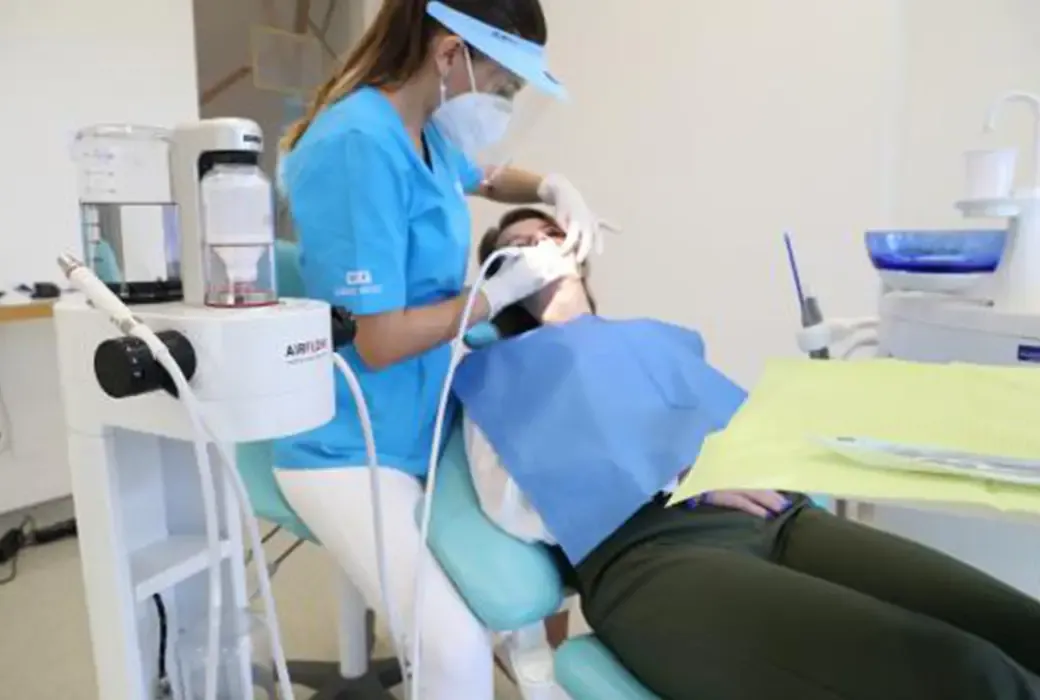
Innovation in dental prophylaxis
The difference between GBT and traditional professional hygiene
If smiling is the universal language of happiness, the oral cavity is the gateway to general health.
In fact, the oral cavity represents an entire microbial ecosystem, called the human oral microbiome, populated by more than 6 billion bacteria, from 700 different species in a single person, according to specialized studies.
These bacteria play an extremely important role in maintaining optimal oral and general health. Some of the bacteria in the oral cavity, pathogenic bacteria, once deposited on the teeth and supporting tissues (gums), can promote dental caries, periodontal disease (gum inflammation, cysts, abscesses) and, left untreated, can even lead to tooth loss in the dental arch.
Also, if an infection develops in the oral cavity, there is a risk that it can be carried to the bloodstream and various vital organs, adversely affecting the overall health of the body.
To ensure that we stay healthy, it is important to take a preventive approach to dental health. And the first step is a daily oral hygiene ritual at home, performed correctly by brushing twice a day for at least 2 minutes and using auxiliary cleaning methods such as flossing, mouth rinse and oral douche.
Although we clean our teeth responsibly, we cannot completely remove plaque from our teeth. It is estimated that 1 mm of plaque contains over 2 million bacteria. Thus, left unremoved, it will lead to tartar build-up and various tooth and gum diseases.
Therefore, it is important to add as preventive methods regular check-ups at the dentist and prophylaxis session once every 6 months, where the doctor or prophylactic assistant carries out a professional sanitization of the oral cavity, where tartar is removed and teeth remain healthy and bright.
Although there are many specialized articles and information campaigns on the importance of the ritual of cleaning teeth at home and in the dental office, there are still many patients who go to the dentist because of severe toothache or a dental emergency caused by an infection.
The evolution of technology in dentistry offers patients the advantage of highly effective and completely pain-free professional hygiene treatment.
What is GBT (Guided Plaque Therapy) technology?
Developed by EMS Dental, Guided Plaque Therapy (GBT) is a Swiss innovation that has enabled hygienists and dentists to transform the patient experience with professional prophylaxis, completely eliminating pain and discomfort.
GBT is a minimally-invasive and gentle technology that can be successfully used for patients with periodontal disease, braces wearers, prosthetic treatments (crowns, dental veneers) and even dental implants.
The aim of GBT is to remove plaque from the teeth and gums to prevent cavities and periodontal disease.
The treatment protocols are safe, offer the highest degree of patient comfort, have internationally validated efficacy and are performed minimally invasively and in conditions of maximum patient safety.
GBT utilizes AirFlow technology to remove plaque from the oral cavity in the safest and most comfortable way for the patient.
Differences between GBT and traditional professional sanitation
GBT
- Pain-free, very useful for patients with sensitive teeth;
- Methods can be used on implants, prosthetic work and dental appliances;
- The scaler also has a Teflon-coated end that allows for implant sanitization;
- Airflow penetrates up to 9 mm subgingival to teeth, implants or forks;
- Airflow can be used on mucous membranes and the tongue, where much bacteria is found;
- Heats water to 25, 30, 35 and 40 degrees;
- Used to treat mucositis or periimplantitis;
- Minimal aerosol dispersion;
- Airflow effectively cleans the interdental areas and is recommended for teeth with exposed eruptions;
- Starts with plaque staining, followed by airflow, followed by scaling, does not require tooth brushing.
TRADITIONAL PROFESSIONAL SANITATION
- Tooth sensitivity may occur during or after scaling;
- Airflow or scaling on implants is not recommended;
- Classic scaling loops cause lesions on implant surfaces;
- Classic airflow can injure the gingiva if inserted subgingivally;
- Classic Airflow is only used on the teeth, not the soft parts;
- Does not heat water;
- Not to be used on implants;
- Higher aerosol dispersion;
- Fork cleaning is reduced;
- Initial scaling, then airflow, then tooth brushing.
How GBT works
- An assessment of the oral cavity is carried out to identify possible dental caries or periodontal disease. This allows the hygienist or dentist to know the treatment needs of patients.
- To identify all plaque on the teeth and subgingival area, plaque disclosure is used. This allows both the hygienist and the patient to see exactly where plaque is deposited and the area over which it is spreading.
- Depending on the patient's needs, three types of technologies are used in combination to perform the GBT procedure, which ensure successful treatment: AIRFLOW® and PERIFLOW® and PIEZON® PS No Pain.
- The procedure concludes with a post-treatment reassessment and the teeth are protected with a fluoride shield.
- The scheduling of the next prophylaxis session will be made at the dentist’s recommendation, depending on the oral clinical examination and the identified conditions. This usually takes place every 6 months.


